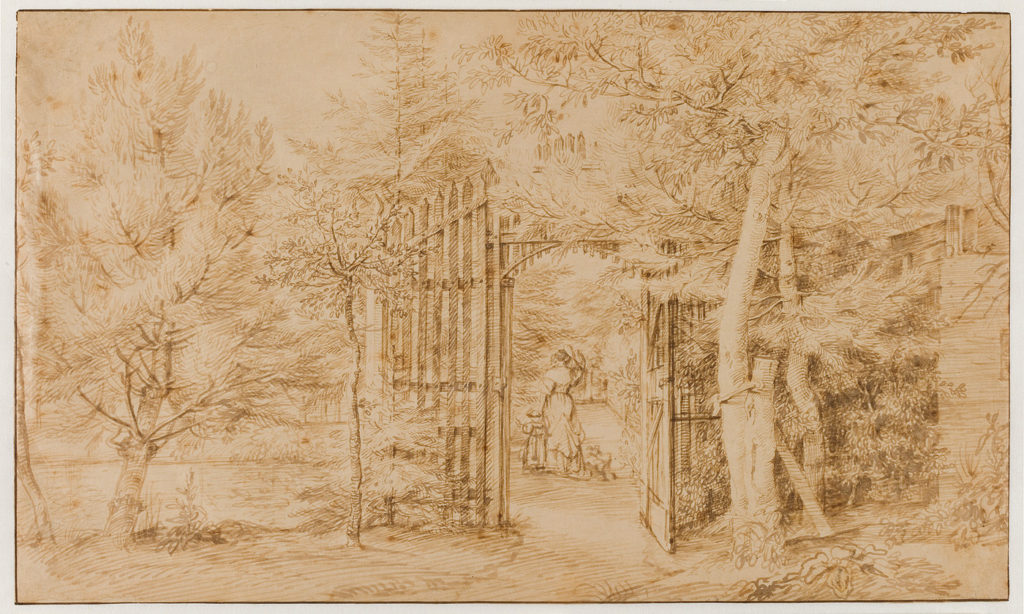Watermark research is increasingly used in research of major artists and new techniques greatly expand the applicability of watermark research and its outcomes. Identification of a sheet’s watermark can give insight into the date and place of origin of a drawing, print or book. When different sheets are compared, the watermark can prove their connectedness because similar watermarks indicate a common date and origin. Compared with traditional methods of art history, watermarks can be useful in establishing authorship and year of production of an artwork on paper but also working practice. In this paper I will call for increased watermark research in specifically landscape sketchbooks by Dutch artists in Rome.
We know about Dutch artists drawing in Rome and about early modern sketchbooks from extant specimen, inventories and catalogues and from biographers. At the dawn of the seventeenth century, the Netherlandish painter and art theorist Karel van Mander (1548-1606) advised young art students to travel to Rome and study Roman “canvas, stone and copperplates”. Specifically, he suggests his readers to “steal arms, legs, bodies, hands [and] feet” through painting, drawing and sketching. According to Van Mander, the drawings must be brought back from Rome to be employed throughout the artist’s career in the Netherlands.[1] He goes as far as to criticize Bartholomeus Spranger (1546-1611) for not drawing and leaving Rome without artworks, although he argues that Spranger’s memory was adequate to reproduce what he had seen.[2] According to Arnold Houbraken (1660-1719), the German artist Filip Peter Roos (1657-1706) was not reluctant about drawing but had to ask his fellow artists who had brought their “portfolios under their cloaks” (emphasis mine) for materials because he had forgotten his own.[3] Hendrik Graauw (c. 1627-1693) also drew while in Rome, and, according to Houbraken, obediently brought back his drawings to the Netherlands.[4] Combined with the many Dutch drawings of Italian ruins, landscapes and artworks that currently reside in museums around the world and through inventories and auction catalogues is clear that artists travelled to Rome and drew during their voyages.[5] Thus, the Italian antiquities and landscapes migrated to the Netherlands in large numbers, albeit in paper form.
[1] Karel van Mander, Den Grondt Der Edel Vry Schilder-Const: Waer in Haer Ghestalt, Aerdt Ende Wesen, de Leer-Lustighe Jeught in Verscheyden Deelen in Rijm-Dicht Wort Voor Ghedraghen, vol. 2 (Haarlem, 1604), 5r-7r.
[2] Van Mander, Den Grondt Der Edel Vry Schilder-Const, 271r-271v. Concerning the different interpretations of this section, see Thomas DaCosta Kaufmann, ‘Reading Van Mander on the Reception of Rome : A Crux in the Biography of Spranger in the Schilder-Boeck’ (Fiamminghi a Roma 1508-1608, Brussels, 1995).
[3] Arnold Houbraken, De groote schouburgh der nederlantsche konstschilders en schilderessen: waar van ’er veele met hunne beeltenissen ten tooneel verschynen, … zynde een vervolg op het schilderboek van K. v. Mander … (The Hague: J. Swart, C. Boucquet, M. Gaillard, 1753), 280.
[4] Houbraken, De groote schouburgh, 190.
[5] Employing sketchbooks was not only used in Rome or Italy. A solid argument is the sketchbook by Roelant Savery (1576-1639). He drew everything he ought painterly in a book whilst in Tirol. Both contemporary biographies and inventories and surviving objects argue for this practice. See, for example, inv. nos. RP-T-00-598 and RP-T-1939-9 from the Amsterdam Rijksmuseum. For notes in early biographies, see Sandrart, Teutsche Academie, 305; Houbraken, De groote schouburgh der nederlantsche konstschilders en schilderessen, 57.

